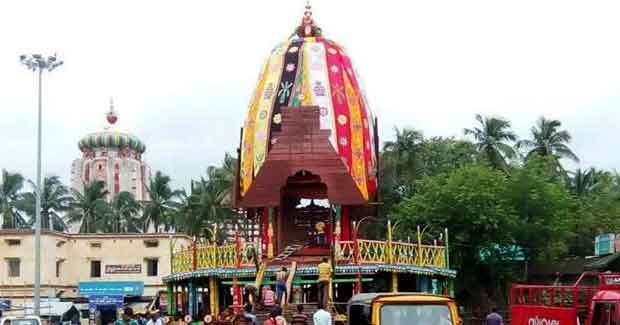Keonjhar: Car festival in Keonjhar district headquarters is not only famous for the chariot being the tallest in the world but also for the tribal culture and history associated with it.
The ‘Bhuyan’ and ‘Juanga’ tribes used to build the traditional rope with the ‘siali’ creeper. It was used to pull the 16-wheeler and 72-feet high ‘Nadighosh’ chariot, which carries Lord Jagannath, his brother Lord Balabhadra and sister Devi Subhadra to Mausi Maa Temple.
Now, coconut choir and plastic ropes are being used along with ‘siali’. The making of the ‘siali’ variant of rope is time consuming and costly so other varieties are being used also.
In 1661, the then king Laxmi Narayan Bhanj Deo dreamt about Lord Balabhadra and brought his idol from a river bed. Then he constructed the Baldevjew temple. And since then till date the car festival has been religiously celebrated with fervour and gaiety. It is a celebratory time for the tribal people of this district.
There are a number of reasons why the ‘Bhuyan’ and ‘Juanga’ tribes play an important role in car festival
According to some local scholars, it is the ‘Bhuyans’ who started the monarchy system in Keonjhar for good governance. They kidnapped the prince from the palace in Mayurbhanj and kept him hidden till he was old enough to be crowned king.
When Keonjhar used to be ruled by kings there used to be special arrangements for the ‘Bhuyan’ and ‘Juanga’ tribes during the car festival.
The tribal people take part in the celebrations wearing traditional clothes and ornaments. They spend the whole night at the ‘bada danda’ singing and dancing. Young boys and girls would spend the entire night dancing together to the beats of ‘changu’ and ‘madal’.
Some of the tribal people also eked out a living during the car festival. They would carry forest produce like fruits, flowers, vegetables and even insects and sell them to interested buyers.
Research worker Bimbadhar Behera however lamented that many of these traditions are not visible anymore during the festival. “One of the most important ingredients of the car festival, was the traditional ‘Jhinka Vivah’ (pull and marry). As a part of the tradition, a young man would choose a girl from same community, put vermilion on her head and pull her towards him. The move signified the tying of the nuptial knot.
As a part of the custom, the family members of the girl then would chase the couple, trying to get back their daughter. However, after a little while they would give him accepting the fact that their girl has got married.
Behera said that this tradition is hardly seen these days during the car festival.
PNN
